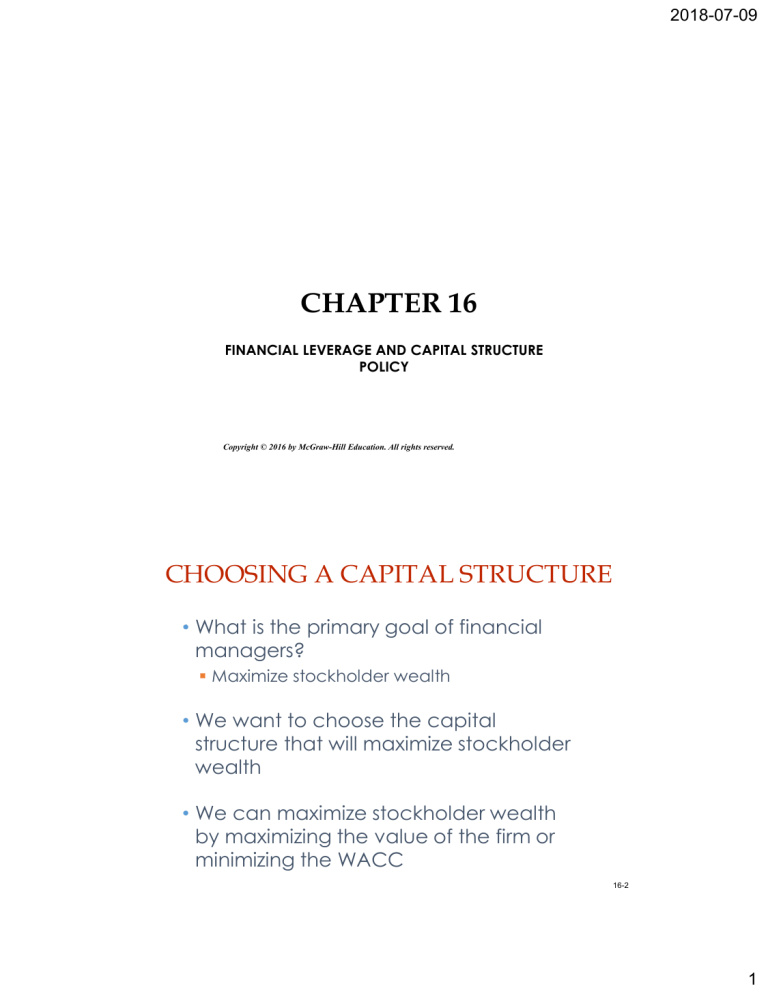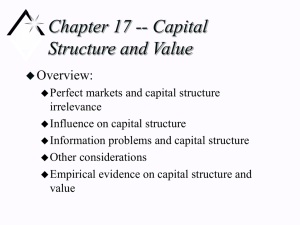
2018-07-09 CHAPTER 16 FINANCIAL LEVERAGE AND CAPITAL STRUCTURE POLICY Copyright © 2016 by McGraw-Hill Education. All rights reserved. CHOOSING A CAPITAL STRUCTURE • What is the primary goal of financial managers? Maximize stockholder wealth • We want to choose the capital structure that will maximize stockholder wealth • We can maximize stockholder wealth by maximizing the value of the firm or minimizing the WACC 16-2 1 2018-07-09 CORPORATE BORROWING AND HOMEMADE LEVERAGE • It is tempting to make a conclusion as follows: – Because of the impact that financial leverage has on both the expected return to stockholders and the riskiness of the stock, capital structure is an important consideration. • Surprisingly, this conclusion is incorrect. – The reason is that shareholders can adjust the amount of financial leverage by borrowing and lending on their own. – This use of personal borrowing to alter the degree of financial leverage is called homemade leverage. 16-3 CAPITAL STRUCTURE THEORY • Modigliani and Miller (M&M)Theory of Capital Structure Proposition I – firm value Proposition II – WACC • The value of the firm is determined by the cash flows to the firm and the risk of the assets • Changing firm value Change the risk of the cash flows Change the cash flows 16-4 2 2018-07-09 CAPITAL STRUCTURE THEORY UNDER THREE SPECIAL CASES • Case I – Assumptions No corporate or personal taxes No bankruptcy costs • Case II – Assumptions Corporate taxes, but no personal taxes No bankruptcy costs • Case III – Assumptions Corporate taxes, but no personal taxes Bankruptcy costs 16-5 CASE I – PROPOSITIONS I AND II • Proposition I The value of the firm is NOT affected by changes in the capital structure The cash flows of the firm do not change; therefore, value doesn’t change • Proposition II The WACC of the firm is NOT affected by capital structure 16-6 3 2018-07-09 CASE I - EQUATIONS • WACC = RA = (E/V)RE + (D/V)RD • RE = RA + (RA – RD)(D/E) RA is the “cost” of the firm’s business risk, i.e., the risk of the firm’s assets (RA – RD)(D/E) is the “cost” of the firm’s financial risk, i.e., the additional return required by stockholders to compensate for the risk of leverage 16-7 FIGURE 16.3 16-8 4 2018-07-09 EXAMPLE: CASE I • Data Required return on assets = 16%; cost of debt = 10%; percent of debt = D/V = 45% • What is the debt-to-equity ratio? D/E = (D/V) / (E/V) = (D/V) / (1 – D/V) D/E = (0.45) / (1 – 0.45) = 0.8182 • What is the cost of equity? RE = 16% + (16% - 10%)(.8182) = 20.91% • Suppose instead that the cost of equity is 25%, what would the the debt-to-equity ratio then to be? 25% = 16% + (16% - 10%)(D/E) D/E = (25% - 16%) / (16% - 10%) = 1.5 16-9 THE CAPM, THE SML AND PROPOSITION II • How does financial leverage affect systematic risk? • CAPM: RA = Rf + A(RM – Rf) Where A is the firm’s asset beta and measures the systematic risk of the firm’s assets • Proposition II Replace RA with the CAPM and assume that the debt is riskless (RD = Rf) RE = Rf + A(1+D/E)(RM – Rf) 16-10 5 2018-07-09 BUSINESS RISK AND FINANCIAL RISK • RE = Rf + A(1+D/E)(RM – Rf) • CAPM: RE = Rf + E(RM – Rf) E = A(1 + D/E) • Therefore, the systematic risk of the stock depends on: Systematic risk of the assets, A, or “Business risk” Level of leverage, D/E, or “Financial risk” 16-11 CASE II – CASH FLOW • Interest is tax deductible • Therefore, when a firm adds debt, it reduces taxes, all else equal • The reduction in taxes increases the cash flow of the firm • How should an increase in cash flows affect the value of the firm? 16-12 6 2018-07-09 EXAMPLE: CASE II Unlevered Firm EBIT Levered Firm 5,000 5,000 Interest 0 500 Taxable Income 5,000 4,500 Taxes (34%) 1,700 1,530 Net Income 3,300 2,970 CFFA 3,300 3,470 16-13 INTEREST TAX SHIELD • Annual interest tax shield Tax rate times interest payment 6,250 in 8% debt = 500 in interest expense Annual tax shield = .34(500) = 170 • Present value of annual interest tax shield Assume perpetual debt for simplicity PV = 170 / .08 = 2,125 PV = D(RD)(TC) / RD = DTC = 6,250(.34) = 2,125 16-14 7 2018-07-09 CASE II – PROPOSITION I • The value of the firm increases by the present value of the annual interest tax shield Value of a levered firm (VL) = value of an unlevered firm (VU) + PV of interest tax shield Value of equity = Value of the firm – Value of debt • Assuming perpetual cash flows VU = EBIT(1-T) / RU VL = VU + DTC 16-15 EXAMPLE: CASE II – PROPOSITION I • Data EBIT = 25 million; Tax rate = 35%; Debt = $75 million; Cost of debt = 9%; Unlevered cost of capital = 12% • VU = 25(1-.35) / .12 = $135.42 million • VL = 135.42 + 75(.35) = $161.67 million • E = 161.67 – 75 = $86.67 million 16-16 8 2018-07-09 FIGURE 16.4 16-17 CASE II – PROPOSITION II • The WACC decreases as D/E increases because of the government subsidy on interest payments RA = (E/V)RE + (D/V)(RD)(1-TC) RE = RU + (RU – RD)(D/E)(1-TC) • Example RE = 0.12 + (0.12-0.09)(75/86.67)(1-.35) = 13.69% RA = (86.67/161.67)(0.1369) + (75/161.67)(9)(1-.35) RA = 10.05% 16-18 9 2018-07-09 EXAMPLE: CASE II – PROPOSITION II • Suppose that the firm changes its capital structure so that the debt-to-equity ratio becomes 1. • What will happen to the cost of equity under the new capital structure? RE = 0.12 + (0.12 – 0.09)(1)(1-.35) = 13.95% • What will happen to the weighted average cost of capital? RA = 0.5(0.1395) + 0.5(9)(1-.35) = 9.9% 16-19 FIGURE 16.5 16-20 10 2018-07-09 CASE III • Now we add bankruptcy costs • As the D/E ratio increases, the probability of bankruptcy increases • This increased probability will increase the expected bankruptcy costs • At some point, the additional value of the interest tax shield will be offset by the increase in expected bankruptcy cost • At this point, the value of the firm will start to decrease, and the WACC will start to increase as more debt is added 16-21 BANKRUPTCY COSTS • Direct costs Legal and administrative costs Ultimately cause bondholders to incur additional losses Disincentive to debt financing • Financial distress Significant problems in meeting debt obligations Firms that experience financial distress do not necessarily file for bankruptcy 16-22 11 2018-07-09 MORE BANKRUPTCY COSTS • Indirect bankruptcy costs Larger than direct costs, but more difficult to measure and estimate Stockholders want to avoid a formal bankruptcy filing Bondholders want to keep existing assets intact so they can at least receive that money Assets lose value as management spends time worrying about avoiding bankruptcy instead of running the business The firm may also lose sales, experience interrupted operations and lose valuable employees 16-23 FIGURE 16.6 16-24 12 2018-07-09 FIGURE 16.7 16-25 CONCLUSIONS • Case I – no taxes or bankruptcy costs No optimal capital structure • Case II – corporate taxes but no bankruptcy costs Optimal capital structure is almost 100% debt Each additional dollar of debt increases the cash flow of the firm • Case III – corporate taxes and bankruptcy costs Optimal capital structure is part debt and part equity Occurs where the benefit from an additional dollar of debt is just offset by the increase in expected bankruptcy costs 16-26 13 2018-07-09 FIGURE 16.8 16-27 MANAGERIAL RECOMMENDATIONS • The tax benefit is only important if the firm has a large tax liability • Risk of financial distress The greater the risk of financial distress, the less debt will be optimal for the firm The cost of financial distress varies across firms and industries, and as a manager you need to understand the cost for your industry 16-28 14 2018-07-09 FIGURE 16.9 16-29 THE PECKING-ORDER THEORY • Theory stating that firms prefer to issue debt rather than equity if internal financing is insufficient. Rule 1: Use internal financing first Rule 2: Issue debt next, new equity last • The pecking-order theory is at odds with the tradeoff theory: There is no target D/E ratio Profitable firms use less debt Companies like financial slack 16-30 15 2018-07-09 OBSERVED CAPITAL STRUCTURE • Capital structure does differ by industry Lowest levels of debt • Drugs • Computer s Highest levels of debt • Electric utilities • Paper 16-31 16





